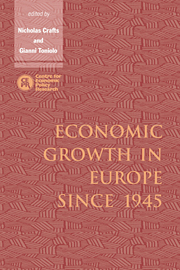Book contents
- Frontmatter
- Contents
- List of figures
- List of tables
- Preface
- List of contributors
- 1 Postwar growth: an overview
- 2 Institutions and economic growth: Europe after World War II
- 3 The varieties of Eurosclerosis: the rise and decline of nations since 1982
- 4 Why the 1950s and not the 1920s? Olsonian and non-Olsonian interpretations of two decades of German economic history
- 5 Convergence, competitiveness and the exchange rate
- 6 British economic growth since 1945: relative economic decline … and renaissance?
- 7 Economic growth in postwar Belgium
- 8 France, 1945–92
- 9 Economic growth and the Swedish model
- 10 Characteristics of economic growth in the Netherlands during the postwar period
- 11 Portuguese postwar growth: a global approach
- 12 Growth and macroeconomic performance in Spain, 1939–93
- 13 Irish economic growth, 1945–88
- 14 Italy
- 15 West German growth and institutions, 1945–90
- 16 An exercise in futility: East German economic growth and decline, 1945–89
- 17 Postwar growth of the Danish economy
- 18 Reflections on the country studies
- Index
6 - British economic growth since 1945: relative economic decline … and renaissance?
Published online by Cambridge University Press: 04 August 2010
- Frontmatter
- Contents
- List of figures
- List of tables
- Preface
- List of contributors
- 1 Postwar growth: an overview
- 2 Institutions and economic growth: Europe after World War II
- 3 The varieties of Eurosclerosis: the rise and decline of nations since 1982
- 4 Why the 1950s and not the 1920s? Olsonian and non-Olsonian interpretations of two decades of German economic history
- 5 Convergence, competitiveness and the exchange rate
- 6 British economic growth since 1945: relative economic decline … and renaissance?
- 7 Economic growth in postwar Belgium
- 8 France, 1945–92
- 9 Economic growth and the Swedish model
- 10 Characteristics of economic growth in the Netherlands during the postwar period
- 11 Portuguese postwar growth: a global approach
- 12 Growth and macroeconomic performance in Spain, 1939–93
- 13 Irish economic growth, 1945–88
- 14 Italy
- 15 West German growth and institutions, 1945–90
- 16 An exercise in futility: East German economic growth and decline, 1945–89
- 17 Postwar growth of the Danish economy
- 18 Reflections on the country studies
- Index
Summary
Introduction
It is a commonplace that the growth and productivity performance of the British economy has been disappointing in the postwar period, at least until the 1980s, which can be regarded as still controversial. Explanations for this ‘failure’ abound in the literature, as Alford's (1988) introductory essay well reflects. It will be useful at the outset to distinguish between three categories of analysis to which we can return in the concluding section, after the details of the historical record have been reviewed.
First, we can look at proximate sources of growth in the manner of growth accounting, which shows both low investment and low productivity growth in the UK compared with its peer group. Second, we can explore the correlates of these aspects of growth performance in terms of their association with particular forms of institutions or policies, such as vocational training systems and ill-conceived industrial policy. Third, and most difficult, we can consider the fundamental factors which sustain the relatively low growth path as an equilibrium. Here we need to consider the incentive structures facing decision-makers both in business and in government, which produced market failure and/or precluded effective supply-side policy responses.
In exploring the UK's growth performance we can take advantage of insights from recent work in growth economics. In particular, it will be useful to bear in mind the following points. First, new models of growth have tended to reassert the importance of capital accumulation and have, in effect, proposed various ways of endogenizing technical progress and productivity change.
- Type
- Chapter
- Information
- Economic Growth in Europe since 1945 , pp. 131 - 172Publisher: Cambridge University PressPrint publication year: 1996
- 36
- Cited by



